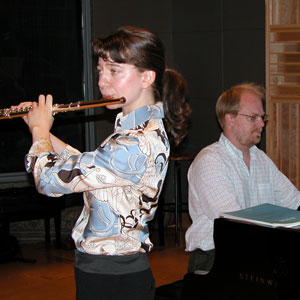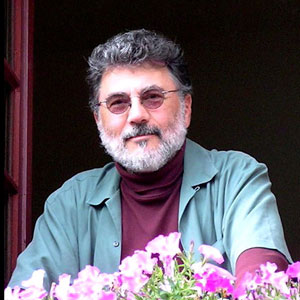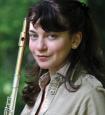Flutists are particularly active in commissioning, premiering, and performing new music. I think our collective interest in contemporary music stems from several factors. First, the flute is more of a solo instrument than other winds but has a smaller solo repertoire than violin, piano, and cello. Second, there was a long hiatus in major contributions to the flute repertoire after the Baroque and Classical periods. Finally, many of the most important 20th-century composers – Debussy, Prokofiev, Dutilleux, Boulez, and Copland to name but a few – wrote substantial flute pieces. Flutists have embraced the music of today’s composers to a remarkable extent, and many works by living composers have become staples of the repertoire.

Playing today’s music is one of the most rewarding aspects of being a musician for me, and premiering music written specifically for me is deeply gratifying. It is exciting to talk with composers about their creative process, and learn about the music through them. The opportunity to ask a living composer what he or she intends is a great benefit.
To explore new flute music from the composers’ perspectives, I interviewed several composers with whom I have worked to ask about their approaches to flute writing. These composers included George Crumb, Ned Rorem, Jennifer Higdon, Curt Cacioppo, Lowell Liebermann, Katherine Hoover, Daniel Dorff, Allen Krantz, Dianne Goolkasian Rahbee, Robert Maggio, Benjamin C.S. Boyle, David Amram, Dianne Gookasian Rahbee, and Jeremy Gill. Two of the composers, Higdon and Hoover, are flutists, and several have a wind-playing background, including Crumb, Boyle, Dorff, Gill, and Maggio. Cacioppo and Krantz have performed frequently with flutists.
What makes a good flute piece?
Several composers said that what is true of good music for any instrument or ensemble is also true for flute. Crumb stated that a good piece of music is “well-conceived, projects, makes the instrument shine,” and “brings out the potential of the instrument in achieving the overall musical conception.” Several agreed that a good piece showcases the strengths and particular voice of the instrument.
.jpg) Flutist and composer Higdon has written numerous excellent flute works, including Autumn Reflection, which I had the pleasure of premiering. She says that it is important that “the music written fits the instrument and isn’t awkward to perform (which is different than being challenging)…the most important aspect of a good piece in general is that it’s interesting to listen to.”
Flutist and composer Higdon has written numerous excellent flute works, including Autumn Reflection, which I had the pleasure of premiering. She says that it is important that “the music written fits the instrument and isn’t awkward to perform (which is different than being challenging)…the most important aspect of a good piece in general is that it’s interesting to listen to.”
Hoover, well-known for many solo and chamber pieces, thinks a good flute piece is “one that allows the instrument to speak, and has something interesting to tell the audience.”
Important Elements
.jpg) Some composers noted specific aspects that are crucial for a good flute pieces. Maggio says that “a key element is understanding breathing and registral color.”
Some composers noted specific aspects that are crucial for a good flute pieces. Maggio says that “a key element is understanding breathing and registral color.”
Krantz, guitarist and Temple University professor, considers it “important to write in a range that lets the flute be heard without strain,” and that “the natural agility of the flute should be served in some way.” He has written several flute and guitar works and recently did a flute and guitar arrangement of his guitar Sonata that we premiered and recorded. Our Metal and Wood Band (flute, guitar, viola, and double bass) recently premiered and performed his Metal and Wood.
Dorff, a Philadelphia-based composer and Director of Publications at Theodore Presser, notes that while the concept of a good piece is subjective, flutists should “want to play it. The Bach Partita and other such solo pieces may present breathing problems, but the challenges are enticing and the music’s quality is well worth the effort.”
Influences
Most thought that studying the canon of repertoire should be part of every composer’s training. Listening to existing works, according to Higdon, gives composers “familiarity with what the highs and lows of the range sound like, and how to balance the instrument against other instruments. It’s also a good way to look at technical limitations, such as how an instrument handles leaps, articulations, and tempi.”
Gill admitted, “If a particular passage in the flute repertoire catches my fancy, I won’t hesitate to emulate it or steal it outright, but I don’t listen to the repertoire hoping to find such things.” Indeed, a passage in his Parabasis shares a connection to a passage in Dutilleux’s Sonatine, an influence Jeremy confirmed when I asked him about it.
Maggio listens voraciously to the repertoire of the instrument or ensemble he composes for, saying he is “always inspired by the flute repertoire; it’s incredibly varied and rich.” Hoover considers listening to an instrument’s repertoire to be an important part of her research, and says that “the flute literature actually pushed me into writing, as I was oversaturated in it and wanted something new.”
Boston-based composer Dianne Goolkasian Rahbee refers to great pieces in the repertoire for inspiration. She wrote Bagatelles for flute and piano for me when I was nine years old. I recently premiered her Sonata for Flute and Piano and a flute concerto is in progress.
Some composers, such as Boyle and Dorff, pointed out potential drawbacks of studying the repertoire. Dorff credits experiences studying each instrument and listening to friends practice as more important than listening to the repertoire. For Higdon, “being a former flutist, I tend not to do this when writing for the flute, as I know so much of the repertoire.” She does study the repertoire of other instruments.
When asked what flute piece or moment in an orchestra or chamber work with flute they found the most beautiful, effective, or original, the broad range of responses provided a unique insight into their approaches to the instrument. Several types of flute music figured prominently, such as music by Mozart, Debussy, Ravel, and later French composers. Some composers said there are so many special flute moments they found it difficult to single out one specific example.
Crumb is interested in how the flute came into its own in the 20th century after a period of neglect. “When music exploded in the late-19th century, the flute was well-suited to what it was called upon to do,” he says, citing how Debussy’s Syrinx and Varèse’s Density 21.5 made the flute function as an unaccompanied instrument, exploring “a wide range of colors” and paving the way for later generations of composers. He quoted Syrinx in his Idylls for the Misbegotten.
For Crumb, the solo in Brahms’ Symphony #4 “is a striking example of flute music of a certain mode. In orchestral music Stravinsky used the flute, and more so the clarinet and bassoon, in a particularly imaginative way. French composers were also very important as an example for me.” Other standouts include the opening of Debussy’s Afternoon of a Faun, Bartok’s flute writing, and the solo in Tchaikovsky’s B-flat minor piano concerto. Of the last he said, “No other instrument could achieve its precise emotional coloration. The flute is perfectly used in the composite sound, with strings.”
 Cacioppo, a composer, pianist, and professor at Haverford College, is captivated by “the quality of ascent that the instrument conveys, of liberation from heavy burdens, of clarity and flight, as in the G-major solo at bar 329 in [Beethoven’s] Leonora Overture # 3, or the “et incarnates est” solo in the Missa Solemnis. Once one has heard the intimacy, mystery, and consolation of its low register, as in the Canzone of Barber’s Piano Concerto, it can speak powerfully too, especially when coupled with piccolo – think of nine bars before the end of the Beethoven 9th Symphony first movement or in the storm section of the Pastorale Symphony.
Cacioppo, a composer, pianist, and professor at Haverford College, is captivated by “the quality of ascent that the instrument conveys, of liberation from heavy burdens, of clarity and flight, as in the G-major solo at bar 329 in [Beethoven’s] Leonora Overture # 3, or the “et incarnates est” solo in the Missa Solemnis. Once one has heard the intimacy, mystery, and consolation of its low register, as in the Canzone of Barber’s Piano Concerto, it can speak powerfully too, especially when coupled with piccolo – think of nine bars before the end of the Beethoven 9th Symphony first movement or in the storm section of the Pastorale Symphony.
“Brahms recognizes the pathos it can express in the solo variation in the last movement of the 4th Symphony, [and Bach’s] 5th Brandenburg (for the transparency of the outer movements and the poignancy of the 2nd.) I always marvel at what the flute adds to the B-natural appoggiatura in the last bar of the St. Matthew Passion.”
Idiomatic Writing
Instrumentalists evaluate whether a composer has written idiomatically for their instrument, so I asked composers whether they think in these terms while writing, and whether they purposely push technical boundaries. Dorff and Maggio initially write music they want to hear, later evaluating it for awkwardness. The flutists in the group, Higdon and Hoover, responded that they automatically consider idiomatic issues. Higdon said she loves pushing boundaries on purpose, as she did in Rapid Fire for solo flute, and Gill also consciously explores new sounds. Dorff, Maggio, and Hoover tend not to push technical boundaries on purpose, but think of technical effects as the result of decisions about the musical content.
Extended Techniques
When asked about the most effective uses of extended techniques, Hoover voiced a conviction shared by several of the composers, that they are most effective “when these techniques are a seamless part of the music.” Higdon agrees that extended techniques must be demanded by the music, “not for the sake of just using extended techniques.”
Dorff pointed out that flutter tonguing was shocking when Ravel and Mahler employed it but is hardly considered an extended technique today. Crumb, Gill, and Maggio credited Density 21.5 for its important early usage of extended techniques. Crumb described the repertoire of extended techniques in great detail, noting that he originated the speakflute technique he used in Vox Balaenae (Voice of the Whale), and how he has also absorbed techniques from flutists such as Robert Aitken and Sue Ann Kahn. Crumb is well-known for his pioneering use of extended techniques in his flute works, a lead many other composers have followed.
Piccolo and Flute Comparisons
Crumb pointed out that the piccolo has a “unique range and coloration” of its own, as does each member of the flute family. Dorff is surprised that a large piccolo repertoire does not exist because he finds the instrument rich in technical and expressive possibilities. Several composers analyzed the colors of different ranges of the piccolo. Maggio is particularly interested in the piccolo’s low range and its ability to be heard at the top in orchestra or concert band textures. Krantz is “attracted to the lyric, Japanese side of the piccolo” in its lower range.
Feedback from Flutists
Almost all of the composers value input from the performers who play their music, especially advice on awkward passages, technical problems, and phrase lengths for breathing purposes. Crumb, with his characteristic humility, described how “every composer has second thoughts. [The piece] either works or it doesn’t work. You can hear if it is impracticable or not idiomatic. When you’re composing it is internal, even when you play things on the piano. Go to rehearsal and it is externalized, like a listener hearing it for the first time. Then you either change it or if it’s a colossal failure, throw it away.”
Writing for a Specific Performer
I asked whether writing for a specific flutist affected the final outcome, and Dorff noted that he drew on aspects of my playing when he wrote Nocturne Caprice for me. The personality of the performer deeply affects Rahbee’s music. The influence “is not necessarily deliberate, but somehow is subconsciously integrated into the music.” Boyle is one of the composers who most takes the individual performer into account, spending “a great deal of time studying their sound before writing the first pitch.” Maggio compared the process to “the way a playwright or a screenwriter might write a part differently if they knew who was going to play a particular role.”
The Flute’s Voice
Composer Shulamit Ran has said that she strives in her music to capture the soul of every instrument. When asked to describe the soul of the flute, Rorem said that “song is the basis for all music,” and “flute music is song with the voice removed; with the flute as the voice.” For Higdon, it is “beautiful, like a river, always changing in sound and flow.” Krantz averred, “the essence of the flute is lyric sunshine, but in the hands of a great player there is much more, including the noir of tango. I’ve come to love the lowest dark notes.”
I am grateful to my composer friends for their thoughtful and illuminating answers to my questions. They have all enriched our repertoire with their music. As flutists it is important that we study, perform, and commission new works in order to contribute to the repertoire and create an important legacy for our instrument. I am certain that Curt Cacioppo speaks for all of us when he expressed so simply and pointedly, “life without the flute would be unimaginable.”






